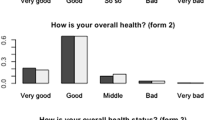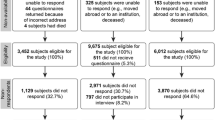Abstract
There is an interest in the consequences of deriving a single index measure of health for validity and sensitivity. This paper presents the results of testing a recent example of a general health measure designed to derive a single index, the Euroqol (EQ), and presents a comparison with a new, influential profile measure, the Short Form 36 (SF-36) Health Survey Instrument. The EQ and an anglicised version of the SF-36 health survey, both designed for self-completion, were included in a postal survey of a random sample of 1980 patients from two practice lists in Sheffield, UK. The response rate for the EQ questionnaire was 83%, and the rate of completion over 95%. Evidence was found for the construct validity of the EQ dimension responses and the derived total EQ health score in terms of distinguishing between groups with expected health differences. Considerable agreement was found between EQ responses and the total EQ score, and the UK SF-36 profile scores. There was substantial evidence of EQ being less sensitive at the ceiling (i.e. low levels of perceived ill-health) and throughout the range of health states. A recent restructuring of the EQ, may help overcome some of the problems with the physical dimensions by reducing their skewness.
Similar content being viewed by others
References
Wilkin D, Hallam L, Doggett MA. Measures of need and outcome for primary health care. Oxford: Oxford Medical Press, 1992.
Bowling A. Measuring health, a review of quality of life measurement scales. Milton Keynes, Open University Press, 1991.
Carr-Hill R, Morris J. Current practice in obtaining the ‘Q’ in QALYs: a cautionary note. Br. Med. J. 1992; 303: 699–701.
The EuroQol Group. EuroQol: a new facility for the measurement of health related quality of life. Health Policy 1990; 16: 199–208.
Ware JE, Sherbourne CD. The SF-36 Short-Form health status survey 1, conceptual framework and item selection. Med Care 1992; 30: 473–483.
Kind P. Measuring valuations for health states: A survey of patients in general practice. Discussion paper 76, Centre for Health Economics, University of York, 1990.
Stewart AL, Hays RD, Ware JE. The MOS short-form General Health Survey: Reliability, validity in a patient population. Med Care 1988; 26: 724–735.
Williams A. Review, Article: Stewart AL, Ware JE (eds). Measuring functioning and well-being. The medical outcomes study approach. Health Econ 1992; 1: 255–259.
Brazier JE, Harper R, Jones N, et al. Validating the SF-36 health survey questionnaire: a new outcome measure for primary care. Br Med J 1992; 305: 160–164.
Streiner DL, Norman GR. Health Measurement Scales: a practical guide to their development and use. Oxford: Oxford University Press, 1989.
Aaronson NK, Acquadro C, Alonso J, et al. International quality of life assessment (IQOLA) project. Quality Life Res 1992; 1: 349–351.
Sherbourne Meredith. J Gerontology 1992; 47: S204-S211.
Office of Population Censuses and Surveys. General Household Survey 1988, London: HMSO, 1990.
Kessle RC, Foster C, Webster PS, House JS. The relationship between age and depressive symptoms in two national surveys. Psychology Aging 1992; 7: 119–126.
Goldberg D, Huxley P. Mental illness in the community. London, Tavistock, 1980.
Bindman AB, Kearne D, Lurle N. Measuring health changes among severely ill patients: The floor phenomenon. Medical Care 1990; 28: 1142–1152.
Guyatt G, Walters S, Norman G. Measuring change over time: assessing the usefulness of evaluative instruments. J Chron Dis 1985; 40: 171–178.
Author information
Authors and Affiliations
Rights and permissions
About this article
Cite this article
Brazier, J., Jones, N. & Kind, P. Testing the validity of the Euroqol and comparing it with the SF-36 health survey questionnaire. Qual Life Res 2, 169–180 (1993). https://doi.org/10.1007/BF00435221
Received:
Accepted:
Issue Date:
DOI: https://doi.org/10.1007/BF00435221




